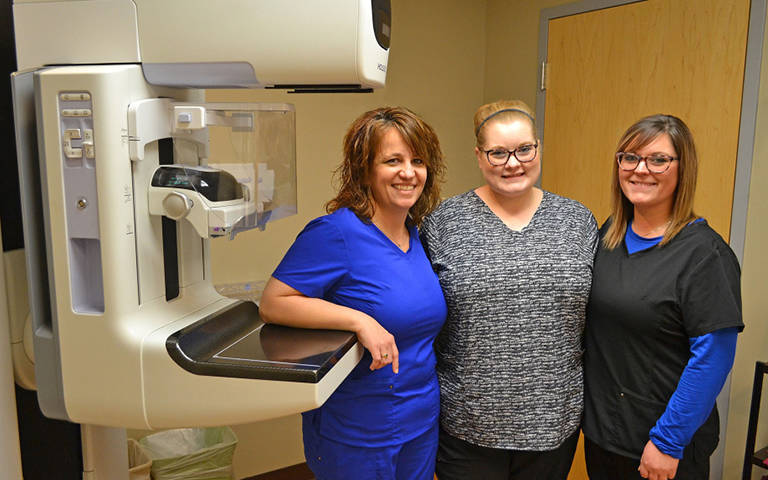As the American Society of Radiologic Technologists’ 100th anniversary approaches, the Bulletin is showcasing RTs going above and beyond for their patients and colleagues.
Why Rural?
Looking back on my upbringing, education, principles, and values, I know that I was not meant to bloom in a large hospital. Working in the rural setting simply feels like a calling. The Harrison County Community Hospital (HCCH) is a thriving, 19-bed critical access hospital. We are located almost exactly halfway between Des Moines, Iowa, and Kansas City, Mo. We are a community hospital serving the district community, treating many individuals from childhood through adulthood.
To serve our patients in this setting, we need to be knowledgeable in many different areas. This has allowed me to specialize in multiple modalities. I love that in one day I could perform mammograms, work with patients receiving a CT or MRI, and then jump over to do a bone densitometry procedure.
I also value the opportunities I have to provide care that is truly centered on the patient and family. RTs are in an ideal position to identify and support patients who may be lost in the shuffle of healthcare. I strive daily to break the cycle for these patients.
We must also be mindful that while imaging is part of our daily grind, these procedures are not the patient’s normal. Though a chest radiograph is our most common exam, it is not common for a patient. And imaging also comes with a side of anxiety, both about the procedure and about what the results could mean. Though a patient may arrive with a cough, we may not know that they have a family history of lung cancer and are fearing the worst. Meanwhile, the patient who was already struggling financially has a broken wrist and cannot work to support their family. Patients struggle with so many different things that they hide. Sometimes just taking an extra minute or two to listen makes all the difference.
It’s the Little Things
RTs may also be able to identify pain points for their patients, even if they aren’t directly related to imaging. For example, we established a coat closet program for patients who come in without a warm coat during the winter. Items are donated by employees of the hospital. Our maintenance crew will even go start a patient’s car so it’s warm for them in the winter, jump start their car, or fix a tire. Small things can make a big impact.
We also make patient follow-up and communication part of our patient-care routine. We had one patient who came to our facility for her yearly mammogram, and it demonstrated an abnormality so the radiologist recommended she follow up in six months. As part of our normal routine, we sent the patient a reminder to have her six-month exam. After this exam, the radiologists requested a biopsy, which came back malignant. After her successful treatment, the patient sent us a beautifully written letter, expressing that our care and concern every time she had her exams encouraged her to follow up here at HCCH. She told us that we saved her life by ensuring she obtained the follow-up exam. This simple part of our usual process helps us ensure patients do not fall through the cracks.
Rural Misconceptions
The larger facilities generally have resources that rural hospitals do not. However, forward-thinking rural facilities can still offer our patients access to services and technology as up-to-date as the metropolitan hospitals. A great relationship with administration and the hospital board is crucial to staying current with technology and increasing revenue and services. Acquiring our own CT scanner in 1996 gave us the ability to better care for our patients in an emergent manner, rather than relying on a mobile CT. Since then, we have had great opportunities, working closely with our vendors to obtain and maintain technology in this ever-changing world of diagnostic imaging.
Relationships Matter
Relationships with your local providers are pivotal to the patients. This camaraderie, mutual trust, and support provide patients with continuity of care. It ensures great communication and positive patient outcomes. At smaller hospitals, the imaging department plays a big role in diagnosis. As RTs, we are well-respected in our field and trusted to make some tough calls when necessary. This is because we have had the opportunity to earn respect from the physicians and providers we work with daily.
Having a strong relationship with our radiologists has always been one of my top priorities. The RT/radiologist relationship is such an important one, especially in rural areas. The RT must relay accurate, detailed information from the patient to the radiologist for the best diagnostic capabilities possible. Mutual respect and open lines of communication between RTs and radiologists are vital for the safety and care of the patient. In the rural setting, we do not have the advantage of having the radiologists in the facility every day. Hence, it is crucial that the RT has the ability and ease of contacting the physicians.
Rural radiology can be done well, and I am proud to say that our department at HCCH exemplifies that — from start to finish. The dedication to improving patient care, the cohesiveness of the RTs, and the steadfast relationships with hospital leadership and radiologists are what define the success of a rural radiology department. To be a leader in this particular subset of radiology is a privilege and honor that I don’t take for granted.
Erica Babinski, RT(R)(M)(CT)(BD), is the director of radiology at Harrison County Community Hospital. She would like to acknowledge the role of Amy K. Patel, MD, in the development of this article.

